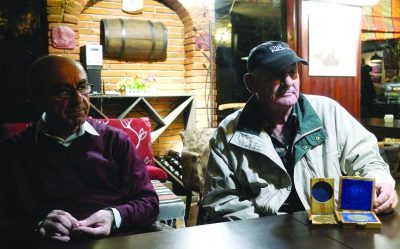Kristallnacht — the night of shattered glass. Just take a moment, and think — sense — the word. We’re used to wailing sirens, the squeal of brakes, the odd private argument that’s become public. But imagine a normal weekday evening, coming home from work, sitting at the table and…suddenly hearing glass crashing, mobs yelling, the reflection of flames in the corner of your eyes. Most of us have had the good fortune to never have experienced riots. Perhaps those that have not been as lucky understand more deeply what Kristallnacht was. Strictly speaking, it was a pogrom. In reality, however, it was the validation of Nazi policy and the green light for the Nazis to take their atrocities to the next level.
Today, the single night that was Kristallnacht has almost become eclipsed by the enormity of the Holocaust that followed; but the build-up of actions that allowed the Holocaust to take place should have just a vital place in our Jewish and human collective memory. Without the book burnings of 1933, the enactment of the Nuremberg racial laws in 1935, without the discrimination against communists, artists and other “subversives,” without the slow expulsion of Jews from universities and gymnasiums, the Holocaust could not have taken place. And Kristallnacht, more than any other individual event, revealed the intentions and capabilities of the Nazi party.
For what the Nazis depicted as a spontaneous, mob action resulting from the assassination of a German diplomat by a Jew, was in fact a highly coordinated, country wide series of attacks executed by Hitler’s original praetorian guard — the SA, or Stormtroopers. What perhaps was spontaneous was the uncoordinated participation of average residents and citizens. And, of course, we cannot forget the numerous bystanders. The reactions of these two groups, perhaps those that simply watched especially, proved to the Nazis that their ultimate plan for the Jews was feasible.
We tend to remember and commemorate the most hideous and unbelievable aspects of the Holocaust – the transports, the ghettos, the liquidations, the final solution. When we say “Never Again,” we are invoking Auschwitz or Treblinka. But we must also remember every single event, every step of the way that enabled the horrors of concentration camps. Kristallnacht symbolizes the culmination of those steps, the beginning of the end.
Seated in a synagogue here in Zurich, waiting for the remembrance event to begin, my mind wanders to the thought: just 70 miles away, only 70 years ago, the synagogue in Konstanz, Germany was reduced to rubble.
A solo clarinetist punctuates the somber atmosphere with haunting Jewish melodies, but I can’t help thinking, here, just 70 years ago, the Swiss minister of justice persuaded the Germans to stamp Jewish passports with a “J,” in order to make it easier for Swiss border patrol to identify the “unwanted.”
When it all ends, when the most evil crime has been committed, then we say “never again.” However, as we reflect on the world around us and events of the last sixty years we realize that “never again” has happened. The lesson we take from commemorating Kristallnacht — don’t wait until the worst has come to pass. Every horrific act is the result of many smaller injustices. We must say “never again” at the beginning.













This piece is brilliant! So poignant, substantive, insightful and raw. Beautiful.
There is a conservative synagogue on the Upper West Side of Manhattan that was founded on the idea/as a consequence of Kristallnacht. In fact, their current rabbi is Josh Katzan, formerly of Hebrew Educational Alliance in Denver Colorado.
Your writing is always stimulating
Thank you
P